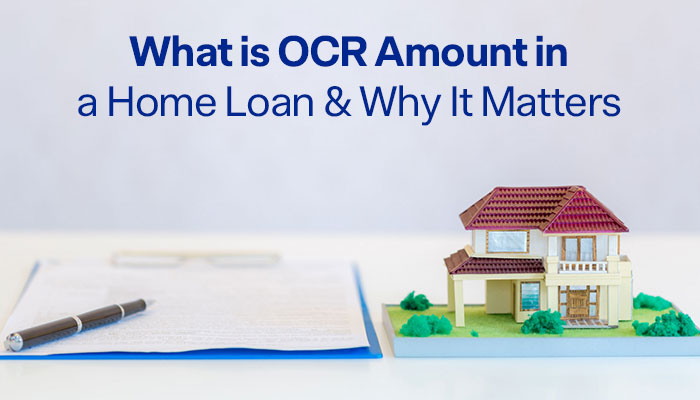Debt-to-Income Ratio and its Impact on your Home Loan Eligibility

Financial ratios are key indicators to analyse your financial position and make important financial decisions. Banks also use certain important financial ratios when deciding on the approval or rejection of the loan application of the borrowers. One such important ratio is the debt-to-income ratio (DTI). The name itself is indicative of what it means. To increase the chances of your loan approval, you should be aware of the debt-to-income ratio. Let’s begin understanding.
What is the Debt-to-Income Ratio?
Debt-to-income ratio is the ratio of debt as compared to the income of the borrower. It consists of totaling your debt payments each month and dividing them by your total monthly income, both active and passive. Your debt repayments should include all your debts whether it's EMIs, credit cards, car loan payments, etc. The lower the debt-income ratio, the better as it shows that your income is higher than your debt. Dividing your debt with income also shows how much more debt you can take as compared to your monthly income.
Here’s the debt-to-income ratio formula:
Monthly debt payments / monthly income x 100
How to calculate your Debt-to-Income Ratio?
Let’s understand how to calculate your debt-to-income ratio with a practical example. Suppose, the following are your financial details:
Car Loan EMI: ₹20,000
Personal Loan EMI: ₹8,000
Credit Card Payment: ₹15,000
Total debt repayment per month = ₹20,000 + ₹8,000 + ₹15,000 = ₹43,000
Your Salary Income = ₹80,000
Therefore, your Debt-to-Income Ratio = Monthly Debt Payments / Monthly Income x 100
= ₹43,000 / ₹80,000 x 100 = 53.75%
Therefore, your debt salary ratio here is 53.75%.
How does Debt-to-Income Ratio affect your Home Loan?
DTI ratio directly impacts your home loan eligibility. Here’s how:
-
Loan Approval: DTI ratio is an important determinant of whether your loan will be approved or not. A lower DTI indicates a lower financial risk to the lender and therefore, increases your chances of loan approval. Conversely, your chances of loan approval decline if your DTI is higher and there is no cushion left for more financing facilities.
-
Loan Amount: In case the lender decides to approve your loan, then comes the loan amount. Loan amount directly impacts your EMI amount and therefore, a lower DTI is crucial if you wish to avail of a high loan amount. Suppose your DTI is 40%. The remaining 60% of your income is needed to fulfill your personal needs as well as cover the EMI of the new loan. Therefore, the lenders may be reluctant to sanction a higher loan amount.
-
Loan Interest Rate: A lower DTI ratio can help you secure a loan at lower interest rates. As you have sufficient income to cover your EMI, it directly reduces the risk of lenders. Therefore, they are comfortable granting you loans at affordable interest rates.
Understanding the Debt-to-Income Ratio
While you have learned how to calculate the debt-to-income ratio, here’s how you can analyse the above:
1) DTI Less Than or Equal to 35%
This shows that your monthly debt payments are less than 35% of your monthly income. DTI in this range shows your good financial standing. In this situation, you can apply for more debt if required.
2) DTI More Than 35% But Less Than 50%
This shows that a significant portion of your monthly income is allocated towards debt payments each month. However, lenders may still consider your application for more debt. But you may have to compromise on the sanctioned amount based on the DTI.
3) DTI More Than 50%
DTI more than 50% indicates that a huge chunk of your monthly income goes towards debt repayments. Thus, you are classified as a high-risk borrower for the lender. This leaves limited room for more liabilities and hence, you may have a hard time applying for more loans from financial institutions. Even if you get more debt, the interest rates can be significantly higher than the normal rates.
In a Nutshell
Debt-to-Income ratio is important not only for loan approval but for also deciding the amount and interest rate on your home loan. Thus, you should ensure that your monthly debt payments do not chew up most of your monthly income. Maintaining a sufficient cushion will help you get a home loan of your desired amount at an affordable interest rate.
You can apply for a home loan with IIFL Home Finance. With simple to fulfill loan eligibility for home loans, affordable interest rates and quicker processing, you can seamlessly apply for home loans to buy or build your dream home. Apply for IIFL Home Loans now!
FAQs
Q1: How can I know my EMIs before applying for a home loan?
A: To know your EMI and total interest payments in advance, you can use the IIFL Home Loan EMI calculator. You just need to enter the loan amount, tenure and interest rate to get accurate EMI and total interest outflow.
Q2: How to reduce DTI?
A: You can reduce your DTI by reducing your debt or increasing your monthly income.
Q3: What are the other factors that influence home loans?
A: Other factors that influence home loans include your income, property, credit score and occupation.
Q4: How can I increase my income to reduce my DTI?
A: You can increase your income by taking up part-time gigs or investing in income-generating assets.
Q5: What is the ideal DTI ratio for a home loan?
A: The lower your DTI, the better it is to avail of a home loan. A DTI below 35% is optimal.
Tags
Disclaimer: The information contained in this post is for general information purposes only. IIFL Home Finance Limited (including its associates and affiliates) ("the Company") assumes no liability or responsibility for any errors or omissions in the contents of this post and under no circumstances shall the Company be liable for any damage, loss, injury or disappointment, etc. suffered by any reader. All information in this post is provided "as is", with no guarantee of completeness, accuracy, timeliness, or of the results, etc. obtained from the use of this information, and without warranty of any kind, express or implied, including, but not limited to warranties of performance, merchantability, and fitness for a particular purpose. Given the changing nature of laws, rules, and regulations, there may be delays, omissions, or inaccuracies in the information contained in this post. The information on this post is provided with the understanding that the Company is not herein engaged in rendering legal, accounting, tax, or other professional advice and services. As such, it should not be used as a substitute for consultation with professional accounting, tax, legal or other competent advisers. This post may contain views and opinions which are those of the authors and do not necessarily reflect the official policy or position of any other agency or organization. This post may also contain links to external websites that are not provided or maintained by or in any way affiliated with the Company and the Company does not guarantee the accuracy, relevance, timeliness, or completeness of any information on these external websites. Any/ all (Home/ Loan Against Property/ Secured Business Loan/ Balance Transfer/ Home Improvement Loan/ NRI Home Loan/ Home Loan for Uniformed Services) loan product specifications and information that may be stated in this post are subject to change from time to time, readers are advised to reach out to the Company for current specifications of the said (Home/ Loan Against Property/ Secured Business Loan/ Balance Transfer/ Home Improvement Loan/ NRI Home Loan/ Home Loan for Uniformed Services) loan.
 Login
Login






















